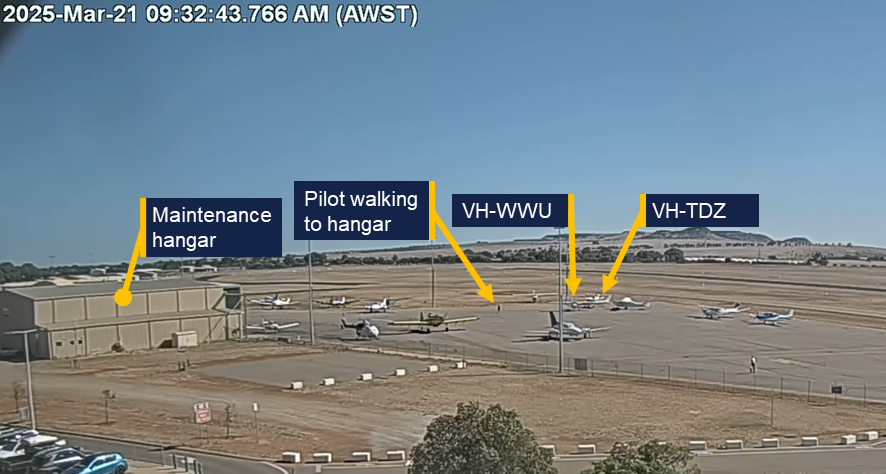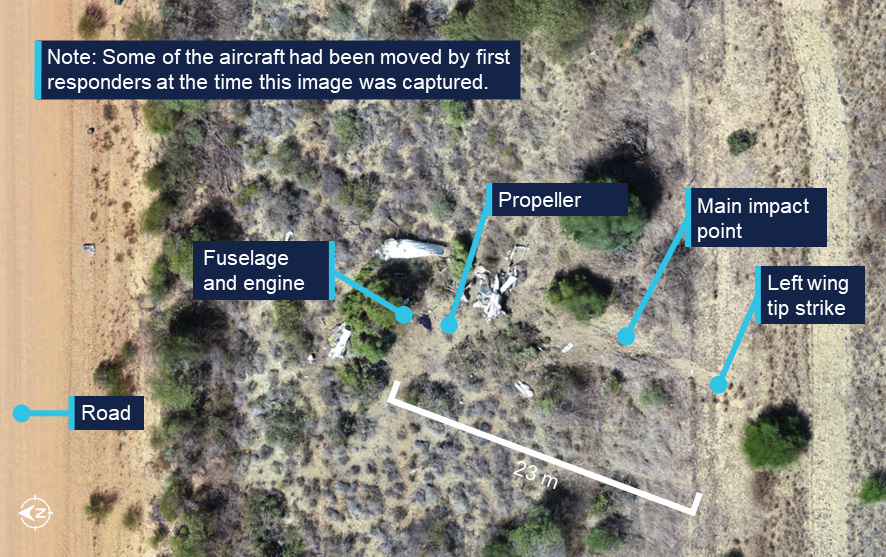This preliminary report details factual information established in the investigation’s early evidence collection phase, and has been prepared to provide timely information to the industry and public. Preliminary reports contain no analysis or findings, which will be detailed in the investigation’s final report. The information contained in this preliminary report is released in accordance with section 25 of the Transport Safety Investigation Act 2003.
The occurrence
Overview
On the morning of 21 March 2025, a pilot was conducting 2 ferry flights of Cessna 150 aircraft that were operated by Norwest Air Work. The first flight, from Shark Bay Airport to Geraldton Airport, Western Australia, involved a Cessna 150M, registered VH‑TDZ. Once at Geraldton Airport, the pilot was to swap aircraft at the maintenance hangar and fly back to Shark Bay Airport in VH‑WWU, the operator’s other Cessna 150M which had been released from maintenance on 18 March 2025.
The pilot was the sole occupant on board both flights. The operator’s senior base pilot was holding SARTIME[1] for both flights.
On the ground at Geraldton Airport
Closed-circuit television (CCTV) showed that the pilot landed VH‑TDZ at 0914:20 local time and taxied the aircraft to the maintenance organisation’s parking bay. At 0922, the pilot texted the senior base pilot informing them of their arrival in Geraldton.
Between 0925 and 0931, the pilot manoeuvred VH‑WWU out of the parking bay and moved VH‑TDZ into it. Once completed, the pilot walked to the maintenance hangar (Figure 1). Witnesses at the airport reported that the pilot appeared unwell and had mentioned having had severe gastroenteritis in the preceding days. Witnesses did not report any apparent speech or physical impairment.
At 0945:15, the pilot left the maintenance hangar, walked to VH‑WWU and conducted a pre‑flight inspection. The aircraft had been refuelled on the morning by the airport refueller. Approximately 2 minutes later the pilot started the engine and taxied the aircraft to the centre apron.
Figure 1: Aircraft changeover

Source: Geraldton Airport, annotated by the ATSB
Geraldton to Shark Bay
At 0955:16, the pilot reported on the local CTAF[2] that they were lining up and rolling on runway 08. The aircraft lifted off the runway 40 seconds later. At 0957:08 the pilot reported they had departed the runway and were tracking out to the north climbing to 2,500 ft through 600 ft. This was the last recorded call from VH‑WWU on the CTAF. Shark Bay is about 340 km north‑west from Geraldton.
Directly after take‑off, the pilot texted the senior base pilot with the expected arrival time at Shark Bay, which was 1230.
At 1008:52, the pilot took a photo of the aircraft oil temperature gauges. Eight minutes later the pilot sent the photo to a staff member at the maintenance organisation with accompanying text stating ‘WWU flies beautiful, smooth, and tight. Oil temp a little high for a cool day so we might have to look at fitting those coolers back onto WWU. I’d hate to see the rings[3] suffer.’ The maintainer responded via text at 1018, and the message was recorded as delivered (indicating that the pilot’s phone was still functional at that time). The oil temperature shown in the photo was towards the upper end of the normal range but below the 240°F maximum oil temperature limit.
At 1116:43, a call was placed to police by a member of the public stating they had come across aircraft wreckage by the side of a road as they were driving past (Figure 2). The accident was 84 km north‑west of Geraldton Airport, and about 0.5 km right of the direct track. The member of the public stated that although they had been nearby, they had not seen or heard the aircraft or the impact.
Figure 2: Original final position of VH‑WWU at the accident site[4]
![Figure 2: Original final position of VH‑WWU at the accident site[4]](/sites/default/files/styles/wide/public/2025-05/AO-2025-014-Figure%20%282%29.png?itok=E57yXZPH)
Source: Western Australia Police Force
The aircraft was destroyed, and the pilot was fatally injured.
Context
Pilot information
The pilot held a commercial pilot licence (helicopter and aeroplane), with both single and multi‑engine class ratings for aeroplanes and a single engine class rating for helicopters. They held low‑level operational ratings for sling, aerial mustering helicopter and aerial musting aeroplane operations. In addition, the pilot held flight instructor ratings for low‑level flight tests in both aeroplanes and helicopters.
The pilot completed single engine aircraft and low‑level flight reviews on 12 February 2024.
The pilot held a valid class 1 aviation medical certificate which was approved in October 2024. This specified a requirement for the pilot to wear distance vision correction and a headset while flying. It also required reading vision correction to be available.
The pilot logbooks were not available at the time of publication.
Aircraft information
The Cessna 150M is a high‑wing, all metal, 2‑place, unpressurised aircraft with a fixed landing gear. VH‑WWU was manufactured in 1976 and was first registered in Australia on 5 May 1986. It had a single, Continental O‑200‑A reciprocating piston engine driving a fixed-pitch propeller. The aircraft was not equipped with an autopilot.
A periodic and other scheduled inspections were carried out between 6–18 March 2025. The periodic inspection identified minor defects that were subsequently rectified. The aircraft’s engine reportedly had excessive oil consumption, and to address the issue all 4 engine cylinders were removed, honed[5] and refitted along with new piston rings. Additionally, the engine ignition harness was replaced due to it being in poor condition. The engine was tested by carrying out a ground run 3 days before the accident and found to be functioning correctly. At the completion of maintenance, the aircraft had accrued a total time in service of 14,208 hours.
Site and wreckage
The wreckage was located about 20 m south of an east‑west road. The Western Australia Police Force and emergency services attended the site on the day of the accident.
The ATSB commenced the accident site examination on the following day, 22 March. The wreckage trail extended in a north‑easterly direction, about 23 m from the initial impact point to where the main wreckage, including the wings, empennage, engine and propeller had come to rest (Figure 3). There was no fire, and fuel could be smelt in the area.
Figure 3: Overview of VH‑WWU accident site

Source: ATSB
Ground impact marks and damage to the airframe indicated that the aircraft impacted the terrain in a left wing‑low, steep nose‑down attitude at high speed (Figure 3). All major aircraft components were accounted for at the accident site. The disruption to the airframe from the impact limited the extent to which the aircraft could be examined. Of the components that could be examined, no pre‑impact defects were identified. Bending and damage to the propeller was consistent with the engine running at the time of impact.
A damaged Garmin 296 GPS receiver was recovered from the accident site. There were no available radar or ADS‑B recordings of the flight.
Meteorological information
The graphical area forecast for the accident region forecasted clear conditions for the flight with no forecast cloud and visibility greater than 10 km.
At 1030, the Bureau of Meteorology (BoM) automatic weather station at Geraldton Airport, 85 km south of the accident location, recorded the wind as 5 kt from 121° magnetic. There was no recorded cloud, visibility was greater than 10 km and the temperature was 34°C.
Further investigation
To date, the ATSB has:
- examined the wreckage and accident site
- recovered the GPS for further examination
- conducted interviews with witnesses and the maintenance organisation
- collected aircraft, pilot and operator documentation
- collected CCTV and CTAF recordings.
The investigation is continuing and will include:
- review and examination of any recovered GPS data
- collection and review of additional pilot medical information
- examination of the aircraft maintenance history.
A final report will be released at the conclusion of the investigation. Should a critical safety issue be identified during the course of the investigation, the ATSB will immediately notify relevant parties so appropriate and timely safety action can be taken.
Purpose of safety investigationsThe objective of a safety investigation is to enhance transport safety. This is done through:
It is not a function of the ATSB to apportion blame or provide a means for determining liability. At the same time, an investigation report must include factual material of sufficient weight to support the analysis and findings. At all times the ATSB endeavours to balance the use of material that could imply adverse comment with the need to properly explain what happened, and why, in a fair and unbiased manner. The ATSB does not investigate for the purpose of taking administrative, regulatory or criminal action. TerminologyAn explanation of terminology used in ATSB investigation reports is available here. This includes terms such as occurrence, contributing factor, other factor that increased risk, and safety issue. Publishing informationReleased in accordance with section 25 of the Transport Safety Investigation Act 2003 Published by: Australian Transport Safety Bureau © Commonwealth of Australia 2025
Ownership of intellectual property rights in this publication Unless otherwise noted, copyright (and any other intellectual property rights, if any) in this report publication is owned by the Commonwealth of Australia. Creative Commons licence With the exception of the Commonwealth Coat of Arms, ATSB logo, and photos and graphics in which a third party holds copyright, this report is licensed under a Creative Commons Attribution 4.0 International licence. The CC BY 4.0 licence enables you to distribute, remix, adapt, and build upon our material in any medium or format, so long as attribution is given to the Australian Transport Safety Bureau. Copyright in material obtained from other agencies, private individuals or organisations, belongs to those agencies, individuals or organisations. Where you wish to use their material, you will need to contact them directly. |
[1] SARTIME ('time search action required'): is the time nominated by a pilot for the initiation of search and rescue action.
[2] CTAF (common traffic advisory frequency): a radio frequency used by pilots at non-towered airports to communicate with each other about their position and intentions, ensuring safe and orderly traffic flow.
[3] Likely referring to piston rings, which wear somewhat more quickly at increased temperatures.
[4] Emergency services personnel moved main sections of the aircraft when removing the pilot.
[5] Honing is a process that scratches a crisscrossed (crosshatched) pattern onto the inside of the cylinder. This pattern reduces cylinder wear by allowing oil to be retained in the scratches rather than be removed by the piston rings.


